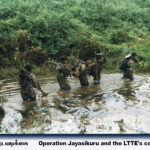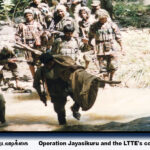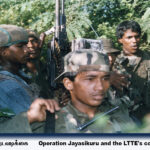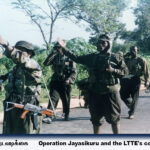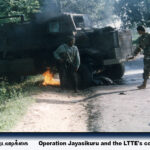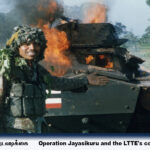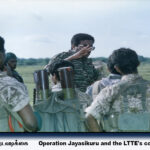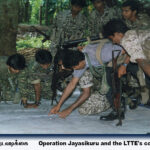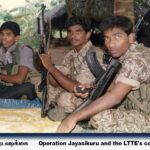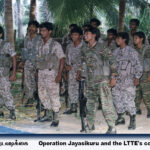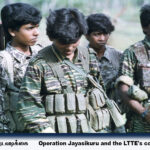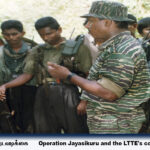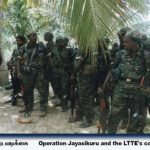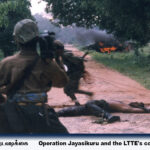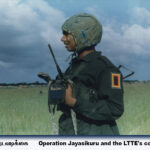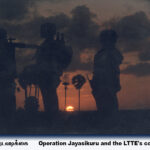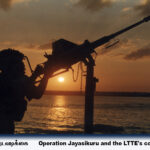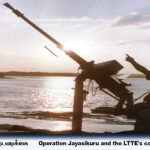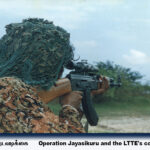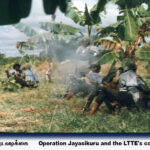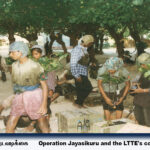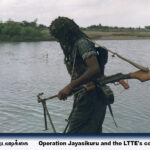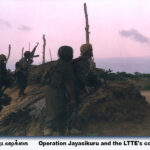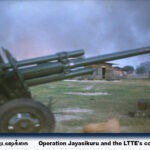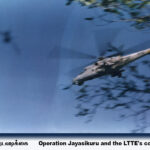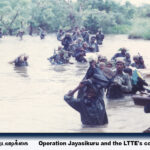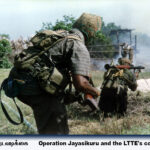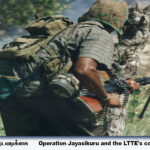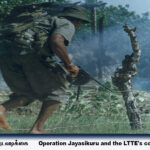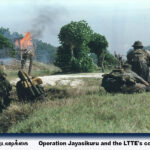

Jeyasikkuru Battle on May 13, 1997
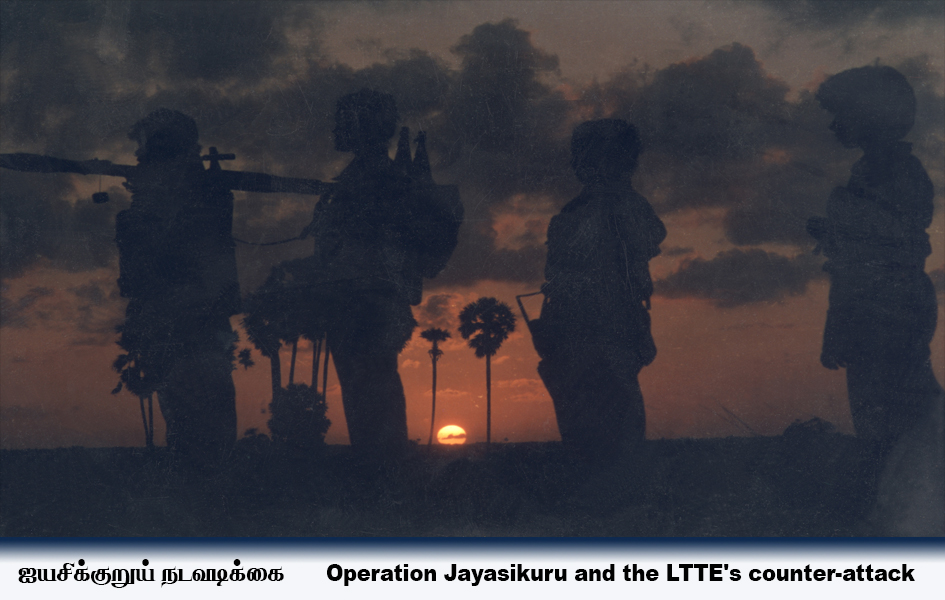
Operation Jayasikuru and the LTTE’s
Operation Jayasikuru and the LTTE’s counter-attack was openend from two ends of Jeyasikkuru Battle on May 13, 1997. Moving through Nochimottai to Omanthai and from there to open the 65 km long Vavuniya-Kilinochchi road is one post. Moving through Dollar-Ken farm and capturing Nedunkeni and from there to capture a part of Vanni is the second post and intention of the enemy. Jayasikuru also had a greedy plan to bring these two fronts together to move and immerse the LTTE, to dissolve their identity and to crush the liberation struggle. Operation Jayasikkuru, which has completed a year, has managed to capture only 35 km of road till date.
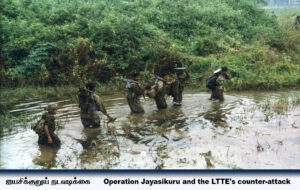 As of today, the operations headquarters has as the goal to capture Mangalam. On the 13th May, the first day of Jayasikkuru Battle, the enemy poured a large number of projectiles on both fronts. The land structure of Vanni and the grandeur of the operations made the need for ranks for the army. As a result, the Sinhalese armored force became the backbone of the Jayasikkuru movement. However, on the third day of the battle, the LTTE dealt a heavy blow to the enemy’s armored forces. They destroyed two ranks in the Omanthay battlefront.
As of today, the operations headquarters has as the goal to capture Mangalam. On the 13th May, the first day of Jayasikkuru Battle, the enemy poured a large number of projectiles on both fronts. The land structure of Vanni and the grandeur of the operations made the need for ranks for the army. As a result, the Sinhalese armored force became the backbone of the Jayasikkuru movement. However, on the third day of the battle, the LTTE dealt a heavy blow to the enemy’s armored forces. They destroyed two ranks in the Omanthay battlefront.
On the eighth day since then, on the 24th May, the soldiers tried to open the Omanthai junction and capture the Irambaikula junction, which was 3 km away. Victor Brigade, the LTTE’s armor brigade, handled the open field and dense jungles well. The LTTE destroyed two more ranks in the day’s fighting that lasted from dawn to dusk. At the same time, the soldiers captured Irampaikulam. However, four days after the beginning of the operation, the commander’s plan to capture Omanthay and Irambaikulam area and execute a the second move from there, took two weeks to complete and lost all four ranks.
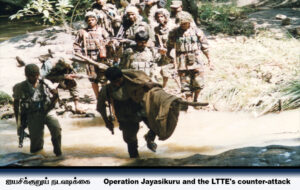 About 125 soldiers was also been killed. The number of wounded soldiers in the two-week battle shocked the army. Around 500 soldiers were injuThis new dimension of combat was created by the barrage and precision of artillery by Colonel Kittu’s regiment. red during this period. This was a new and unexpected military feature for the army. Both, the loss of ranks and the loss of soldiers made the Sinhalese commanders think. It is unusual that the Jayasikkuru Battle lost 04 ranks and about 600 soldiers in only the two week battle. The Sinhalese commanders planned to advance to avoid loss of ranks and to minimize casualties. By increasing their motor artillery strength combined with the movement of the rank, they began to move.
About 125 soldiers was also been killed. The number of wounded soldiers in the two-week battle shocked the army. Around 500 soldiers were injuThis new dimension of combat was created by the barrage and precision of artillery by Colonel Kittu’s regiment. red during this period. This was a new and unexpected military feature for the army. Both, the loss of ranks and the loss of soldiers made the Sinhalese commanders think. It is unusual that the Jayasikkuru Battle lost 04 ranks and about 600 soldiers in only the two week battle. The Sinhalese commanders planned to advance to avoid loss of ranks and to minimize casualties. By increasing their motor artillery strength combined with the movement of the rank, they began to move.
Accordingly, on the 3rd day, the enemy opened up the battle with a heavy shelling and moved towards the Vilakkuvaitha Kulam junction, where the enemy faced only little resistance. The movement of the soldiers became easier. Soldiers captured the Vilakkuvaitha Kulam junction. On the 6th day, the soldiers captured the Panrikkeytha Kulam and then Panikka Neeraaviyaldi.
The LTTE had another plan to keep when the soldiers satisfied after covering a distance of 05 km in three days. While the troops moving forward focusing on capture grounds, The LTTE prepared themselves to launch a fierce attack on the advancing troops. The LTTE tacitly allowed the troop movement to ease the attacks by reducing their strength. The troops moved forward with a float of victory. At midnight on the 10th June, the LTTE gave a shock treatment to the Sinhalese army leadership. When troops knew about the LTTE military movement, they expected heavy attack on the Jayasikkuru positions. But no one expected a massive backlash. No one would have guessed that it would happen already in the start of Vavuniya.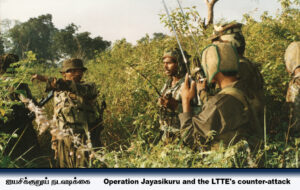
No one thought that the attack would fall on the Jayasikkuru command headquarters. The blow fell. A thunderbolt struck the supply center for Jayasikkuru. The explosives cache was detonated. Two ranks that came to intercept the attack were destroyed in the attack. Three motors were destroyed. Army vehicles caught in fire. Some fell into the hands of the LTTE. 400 soldiers were killed. 570 people were injured. The Nochimottai Bridge was destroyed by the LTTE. The brigadier of Jayasikkuru operation, who led the operation from Thandikulam operation headquarters, escaped to Vavunia and survived. Dozens of soldiers who were trapped inside the attack zone gave up their initiations and survived by wearing clothes/vetti like Tamils.
Special commandos were flown in helicopters to help the besieged soldiers. a M.I was caught in this 24 aircraft was bombed and fell down. The Jayasikkuru operation completed a month with the result of the less attack on Thandickulam. 185 fighters became maveerar on the side of the LTTE in this 1 month-long battle. But up to 500 soldiers were killed. Around 1000 soldiers were injured. In this way the Jayasikkuru Battle lost 1500 soldiers in a month. It took them two weeks to make up for this loss and prepare the soldiers for the next battle. Jayasikkuru´s troops were exhausted by the Thandikkulam attack. Jayasikkuru’s beginning of the journey became ominous, like one who slips at the threshold of a long journey. At this stage, the command wanted to achieve a military victory and overcome this fatigue to galvanize the troops. The military leadership planned to capture Puliankulam and achieve that military victory.
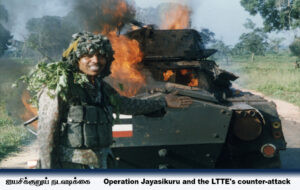 As the soldiers were stationed very close to Puliyankulam, at a distance of 04 km, they were confident of the victory. Exactly on the 12th day (22.06.97) after the massive attack on Thandikulam, the soldiers started the move to the next battle. The soldiers tried to break through the Malathy Brigade’s position and capture Puliangulam Junction, but the women fighters destroyed a tank and killed 15 soldiers. However, the soldiers moving towards Puliankulam – opposite to the place where the fight took place – reached Palayavaadiyadi near Puliankulam junction. On the 24th June – 14 days after the massive attack on Thandikulam took place – the massive attack on Periyamadu, which was the forecourt of “Jayasikkuru”, took place. It is the practice of the LTTE to selectively attack and destroy central positions while carrying out heavy attacks and try to turn the results into a multi-dimensional tactical victory. The soldiers of “Jayasikkuru” were resting when the Thandikulam-Nochimottai attack took place.
As the soldiers were stationed very close to Puliyankulam, at a distance of 04 km, they were confident of the victory. Exactly on the 12th day (22.06.97) after the massive attack on Thandikulam, the soldiers started the move to the next battle. The soldiers tried to break through the Malathy Brigade’s position and capture Puliangulam Junction, but the women fighters destroyed a tank and killed 15 soldiers. However, the soldiers moving towards Puliankulam – opposite to the place where the fight took place – reached Palayavaadiyadi near Puliankulam junction. On the 24th June – 14 days after the massive attack on Thandikulam took place – the massive attack on Periyamadu, which was the forecourt of “Jayasikkuru”, took place. It is the practice of the LTTE to selectively attack and destroy central positions while carrying out heavy attacks and try to turn the results into a multi-dimensional tactical victory. The soldiers of “Jayasikkuru” were resting when the Thandikulam-Nochimottai attack took place.
As a result, the front line was filled with ordinary soldiers – the figthing soldiers retreated and rested in the command center, but it was the command center that was the goal of the LTTE´s attack and therefore many of the killed was fighting soldiers. The distribution center was destroyed. The command post was fragmented. The soldiers were trying to capture Puliyangulam when the Periyamadu attack took place. Because of that the forecourt was filled with newly becomed soldiers. This time the LTTE rushed towards the front. A group ofthe LTTE tried to capture the motor launch site of the enemy by attacking Jayasikuru’s fighting force. The soldiers by the launch site showed fierce resistance. Lt. Colonel Thanam led the fight to break the resistance.
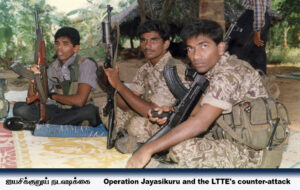 As the launch pad fell, the enemy destroyed his own motors and retreated. Lt. Thanam became maveeran in that heavy battle. 94 other fighters who had many achievements also became maveerar in this attack. 185 sodiers were killed. Up to 200 soldiers were injured. Among the soldiers killed was Colonel Dean, Commanding Officer of the Periyamadu Base. As a result of this attack, the army stationed at Puliyankulam Palayavaadi automatically retreated to Periyamadu. Leader Prabhakaran decided to hold a decisive battle at Puliyankulam. To that, he tasked the LTTE fighters to make the area that included Puliyankulam Junction as a battle base with barracks – and prepare for a prolonged direct battle. Setting up positions to withstand the bombardments of the enemy, the LTTE fighters bravely prepared for a new kind of fight. The enemy also saw the battle camp of a few kilometers in diameter.
As the launch pad fell, the enemy destroyed his own motors and retreated. Lt. Thanam became maveeran in that heavy battle. 94 other fighters who had many achievements also became maveerar in this attack. 185 sodiers were killed. Up to 200 soldiers were injured. Among the soldiers killed was Colonel Dean, Commanding Officer of the Periyamadu Base. As a result of this attack, the army stationed at Puliyankulam Palayavaadi automatically retreated to Periyamadu. Leader Prabhakaran decided to hold a decisive battle at Puliyankulam. To that, he tasked the LTTE fighters to make the area that included Puliyankulam Junction as a battle base with barracks – and prepare for a prolonged direct battle. Setting up positions to withstand the bombardments of the enemy, the LTTE fighters bravely prepared for a new kind of fight. The enemy also saw the battle camp of a few kilometers in diameter.
The army considered the LTTE’s Puliyankulam base formation to be a suicide attempt. It thought that the LTTE were congregating as they wanted – in a small area – and giving themselves a chance. The Puliyankulam battle began. The Puliangulam base was a very small in area . It was the main target of the enemy’s artillery. The base became a target for Kibir bombers and attack aircraft. The field was also shaken by the bombings. At the same time, the soldiers surrounded Puliyankulam in a circular form. Like hawks swooping to attack chicks, the enemy’s tanks also tried to break through and destroy the base of the LTTE. A kilometer ahead, the Malathi Brigade formed a strategic position to secure the site of Puliyankulam.
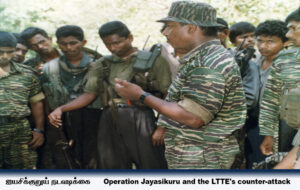 Charles Antony Brigade and Imran-Pandiyan Brigade also stood together inside the Puliyankulam site. As the enemy could not get inside the base by breaching the forecourt as he had intended, he wanted to besiege the base completely and wipe it out. For this purpose, soldiers moving from Nedunkeni also approached to help in the siege of the Puliyankulam site. The LTTE developed a new strategy and expanded the base’s defenses to prevent the siege. The field was gradually expanded by these siege attempts and breakthroughs. The Jayanthan Brigade took charge as the guards of the sprawling field. Sukanya Brigade and the Political Department Brigade joined with them. The LTTE decided to launch another heavy attack while the siege of Puliyankulam was in full swing. At that time, Omanthai Army Base became the supply center for Jayasikkuru soldiers. So, this time Omanthay was the target of the attack. On the 1st day of July, Omanthai – Irambaikulam section was attacked from both ends of the route.
Charles Antony Brigade and Imran-Pandiyan Brigade also stood together inside the Puliyankulam site. As the enemy could not get inside the base by breaching the forecourt as he had intended, he wanted to besiege the base completely and wipe it out. For this purpose, soldiers moving from Nedunkeni also approached to help in the siege of the Puliyankulam site. The LTTE developed a new strategy and expanded the base’s defenses to prevent the siege. The field was gradually expanded by these siege attempts and breakthroughs. The Jayanthan Brigade took charge as the guards of the sprawling field. Sukanya Brigade and the Political Department Brigade joined with them. The LTTE decided to launch another heavy attack while the siege of Puliyankulam was in full swing. At that time, Omanthai Army Base became the supply center for Jayasikkuru soldiers. So, this time Omanthay was the target of the attack. On the 1st day of July, Omanthai – Irambaikulam section was attacked from both ends of the route.
135 soldiers were killed in this third heavy attack on Jayasikuru soldiers. These three major attacks, which took place before the end of three months of the operation, horrified the soldiers. They shattered the prediction and the Sinhalese dream that the LTTE were weak. Meanwhile, in the early morning of the 19th of July, a fight broke out in the Puliyankulam area. Moving from Nedunkeni and approaching Puliyankulam, the soldiers moved closer with a volley of projectiles. While this attack was going on at the south-east end of the Puliyankulam, six tanks of the enemy, who were in a flash from the enemy’s barracks on the north-west side, tried to break away. The LTTE destroyed two tanks at the front place. Another one stood outside, providing access to the platform by providing heavy attack.
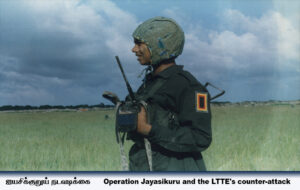 Meanwhile, two tanks and a trooper have successfully stormed inside the base. The LTTE and the Sinhalese stood in the base. The site was stunned by this sudden situation. The site was on the verge of collapse. The fighters of the base were quick to act. They tried to plug the breach in the base to make it impenetrable to the tanks and troops. The fornt fighters did it and announced it. It is not what it was five minutes ago.
Meanwhile, two tanks and a trooper have successfully stormed inside the base. The LTTE and the Sinhalese stood in the base. The site was stunned by this sudden situation. The site was on the verge of collapse. The fighters of the base were quick to act. They tried to plug the breach in the base to make it impenetrable to the tanks and troops. The fornt fighters did it and announced it. It is not what it was five minutes ago.
Now, the tanks and troops are under the LTTE´s custody. The shields of the enemy rolled nervously, confused whether to attack or escape. The trooper ran hither and thither like a trailed cow. The LTTE with R.P.G. The women fighters attacked with a final attack on the troops as they stood and swayed in front of the LTTE’s front base, and the troops was under the custudy of the LTTE. Meanwhile, the Re55 tank managed to climb the ramparts after three heavy attack and escaped past the positions of the Malathy Brigade. The field was tight as there were attacks on all fronts. It was in such situation that when a tank came out from the Puliyangulam main base in the north-east direction, and the Malathy fighters did not attempt to attack. They were confused if the tank was their own tank or the tank of the enemy! When they were clearing the confusion by communicating with the main base, within a two-minute time frame, the tank had entered their safe zone and defended itself. The rest of the tanks arrived fled with lightning speed and end out of the base.
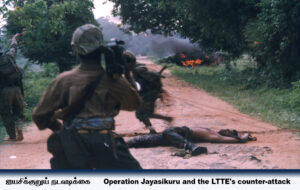 Capitalizing on that advantage, the next day (20.08.1997) the tanks of the enemy attacked the area where the same Malathy Brigade was stationed. The fight was fierce. A tank has been destroyed. Leaving the defensive positions, the Malathy Brigade retreated and joined the main base. Because if this, some positions were in the hands of the enemy. The enemy was a bit excited as the security arrangements, meant to secure the Puliyangulam base, were withdrawn. The Sinhalese armored forces planned to make another move with tank and break through the base. It was implemented in six days. On the 26th of July, the armored forces launched a massive attack from the south towards Puliyangulam. The bombings also aided the movement of armored forces. However, it could not do anything about the base of the LTTE. A tank was also destroyed in the day’s fighting. The attack of the Puliyankulam took place for about five months. The enemy tried all kinds of attacks and tactics. Although the positions were fragmented due to bomb blasts, the LTTE showed their superior fighting skills in the Puliyangulam Battle by standing with determination and courage and preventing the enemy from entering.
Capitalizing on that advantage, the next day (20.08.1997) the tanks of the enemy attacked the area where the same Malathy Brigade was stationed. The fight was fierce. A tank has been destroyed. Leaving the defensive positions, the Malathy Brigade retreated and joined the main base. Because if this, some positions were in the hands of the enemy. The enemy was a bit excited as the security arrangements, meant to secure the Puliyangulam base, were withdrawn. The Sinhalese armored forces planned to make another move with tank and break through the base. It was implemented in six days. On the 26th of July, the armored forces launched a massive attack from the south towards Puliyangulam. The bombings also aided the movement of armored forces. However, it could not do anything about the base of the LTTE. A tank was also destroyed in the day’s fighting. The attack of the Puliyankulam took place for about five months. The enemy tried all kinds of attacks and tactics. Although the positions were fragmented due to bomb blasts, the LTTE showed their superior fighting skills in the Puliyangulam Battle by standing with determination and courage and preventing the enemy from entering.
The Sinhalese army realized by experience that breaking through the LTTE´s Puliyangulam base is to breaking through the stone wall with bare feet. They also found it an impossible military endeavor encircling the Puliyangulam site in a circle. In this situation, the Army Command wanted to implement a strategy of seizing the main supply route to Puliyankulam by isolating the base and forcing the LTTE to abandon Puliyankulam. The Army Command attempted to complicate the presence of Puliyankulam by making a bold move, through the forest, towards Puthoor road, which was 05 km north of Puliyankulam.
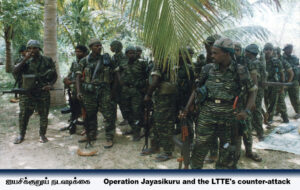 In the dark of the night on the 10th September, a special commando force of the enemy called the Airmobile Battalion, moved east of the main road and captured and occupied Puthoor Junction. Meanwhile a battalion moved to the west of the main road towards Puthoor and the LTTE fighters saw it and attackded it. The tactical intent of the enemy was clear. Now the LTTE had only one choice. Give up the Puliyankulam! Or to protect Puliyangulam by regaining Puthoor Road! The LTTE were determined to defend Puliyankulam and therefore launched a breakthrough attack on the Puthoor Junction area.
In the dark of the night on the 10th September, a special commando force of the enemy called the Airmobile Battalion, moved east of the main road and captured and occupied Puthoor Junction. Meanwhile a battalion moved to the west of the main road towards Puthoor and the LTTE fighters saw it and attackded it. The tactical intent of the enemy was clear. Now the LTTE had only one choice. Give up the Puliyankulam! Or to protect Puliyangulam by regaining Puthoor Road! The LTTE were determined to defend Puliyankulam and therefore launched a breakthrough attack on the Puthoor Junction area.
Before the commandos at the junction could make preparations for their defence, they were attacked. The shelling by Colonel Kittu’s Artillery Regiment roused the commando force. The Jayanthan Brigade and the Naval Brigade launched an attack. The Airmobile Battalion was unable to defend itself due to the with difficult conditions. The LTTE recaptured Puthoor Road before the next day. About 200 soldiers were killed in this night fight. It is noteworthy that as a result of this breakthrough attack Brigadier Sivalivanigasekera, the commander of the Airmobile Battalion, was dismissed and transferred. Puliyankulam continued to be an impregnable battleground.
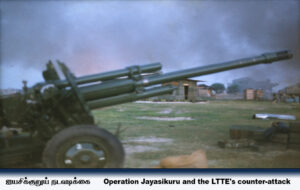 Just like the move to Puthoor Road, the army tried to move to Kanagarayankulam Junction on the 30th day of September. After the lost the soldiers avoided the Puliyangulam Battle and planned to start the fight on the other side. The army leadership speculated that Jayasikkuru´s soldiers were unable to face the attack because the LTTE forces launched a two-pronged attack using the land east and west of the main road captured by Jayasikkuru forces during Thandikkula attack – Periyamadu attack – Omanthai attack. At this stage it decided to turn the entire area into a military control zone to prevent the LTTE from using the eastern part of the route.
Just like the move to Puthoor Road, the army tried to move to Kanagarayankulam Junction on the 30th day of September. After the lost the soldiers avoided the Puliyangulam Battle and planned to start the fight on the other side. The army leadership speculated that Jayasikkuru´s soldiers were unable to face the attack because the LTTE forces launched a two-pronged attack using the land east and west of the main road captured by Jayasikkuru forces during Thandikkula attack – Periyamadu attack – Omanthai attack. At this stage it decided to turn the entire area into a military control zone to prevent the LTTE from using the eastern part of the route.
The troops stationed at Nedunkeni were moved towards Puliyankalam and a landlock was created and the eastern part of the route. As the land was swallowed up, these forces forced the opening of the long line of battle to take a different route, and to divert it to make way to secure what it had captured. As a result, a massive change took place in the Jayasikkuru operation. In those days, speculations were written in Colombo that the soldiers brigade that captured Nedunkeni moved from there to Mullaitheevu or Puthukudiyiruppu via Odduchuddan. But this land-sweeping front only served to open up another battlefront for passage. The enemy made preparations to open a new battlefront called the Karipatta Murippu. The LLTTE had already guessed that a battle was going to be opened a the Karappakutty Vinjaanakulam as the center of supply. The LTTE planned to attack and capture the enemy’s supply center before it opened as a new front. They also marked the date. However, the soldiers were also in a hurry. On the 4th day of October, the troops made a long night march to the Karipattam Junction.
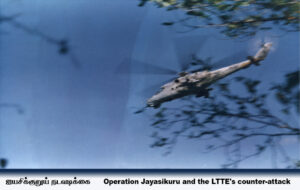 They covered a distance of about 09 km by walking in the darkness. Expanding the domains will also diversify the LTTE’s resistance. If that happens, it will be disadvantageous to the LTTE and with this the army commander made field expansions. Like “Take away a thorn with a thorn”, the LTTE retaliated with counter-attacks that had disastrous consequences for the troops on all the new fronts that had opened up. On 5th October, the LTTE launched a massive attack on Karappukkutty – Vinjaanakulam supply center on the same night that the army captured the Karipattakulam.
They covered a distance of about 09 km by walking in the darkness. Expanding the domains will also diversify the LTTE’s resistance. If that happens, it will be disadvantageous to the LTTE and with this the army commander made field expansions. Like “Take away a thorn with a thorn”, the LTTE retaliated with counter-attacks that had disastrous consequences for the troops on all the new fronts that had opened up. On 5th October, the LTTE launched a massive attack on Karappukkutty – Vinjaanakulam supply center on the same night that the army captured the Karipattakulam.
It was different from the attacks on the Jayasikkuru soldiers. The LTTE seized large quantities of explosives and military equipment, as well as conventional fighting vehicles and bulldozers from here. The LTTE launched a diversionary attack on the supply center during the attack to prevent outside aid from reaching it. Did the LTTE attacking Karippaddamurippu! Or did it attacking Karappukkutti – Vinjaanakulam! The soldiers could not find out. They wrongly guessed that Karippattamurippu was the target of the LTTE. Therefore, the army only had the Karippattamurippu area as the target of their artillery. The Karipattamurippu rocked throughout the night of shelling.
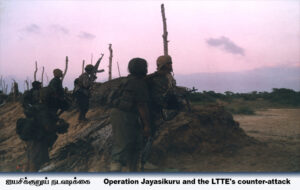 As a result, the intensity of the counter-attack on the LTTE, who hit the real target, was reduced. It made it easy take and save the captured military equipment. Notably, one tank was destroyed in this attack. A diversionary attack on Karipattamurivu was also a bit of a show. The counter-attack was carried out on the same night of the capture, so the soldiers had not completed proper security arrangements. Due to this, the troops of the Karipattamurippu also suffered losses. The soldiers repaired the forest road to supply the army that had moved to Karipattaimurippu. At the same time, the presence of soldiers in Katkidangu and Vinjanakulam area also increased.
As a result, the intensity of the counter-attack on the LTTE, who hit the real target, was reduced. It made it easy take and save the captured military equipment. Notably, one tank was destroyed in this attack. A diversionary attack on Karipattamurivu was also a bit of a show. The counter-attack was carried out on the same night of the capture, so the soldiers had not completed proper security arrangements. Due to this, the troops of the Karipattamurippu also suffered losses. The soldiers repaired the forest road to supply the army that had moved to Karipattaimurippu. At the same time, the presence of soldiers in Katkidangu and Vinjanakulam area also increased.
They were on the way to the Mangulam area. The LTTE is undermanned to stop the soldiers as it responds to troop expansion. So the LTTE had no choice but to make a tactical retreat from some places and prepare to fight where necessary. It was in this situation that leader Prabhakaran decided to retreat from Puliyankulam and prepare for battle by leveling Kanagarayan Kulanchanthi area. The soldiers captured Puliyankulam only after the LTTE abandoned it. After two months of calm following the attack on Karappukkuththy and Vinjanakulam, the troops launched a attack to capture Kanagarayan Kulachanthi on December 4th. Along the main road towards Kanagarayankulam Junction at one end and the commando team trained for ‘Green Parade’ towards Mannakulam at the other end, the Sinhalese force moved through Muththarkulam between Kanagarayankulam and Mannakulam with the aim of capturing Kanagarayankulam by opening a third front.
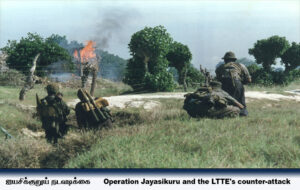 Fighting started at every front. The soldiers who moved through the main route and the SF Battalion moving towards the city through Muththarkulam were stopped. However, the Malathy Brigade, the Intelligence Brigade and the Thirumalai Brigade, which were stationed there, fighted fiercely against the commando forces who came towards Mannakulam. Jayanthan Brigade launched a counter-attack targeting the commandos who breached some of the LTTE’s bastions. The fight was intense. The commandos fought to make what the LTTE had achieved at Puthoor Santhi impossible at Mannakulam. First, they fought to retain their captured land. Then they fought to escape safely. But the LTTE’s daylight breakthrough was heroic and tactical. The Sinhalese commandos were stunned.
Fighting started at every front. The soldiers who moved through the main route and the SF Battalion moving towards the city through Muththarkulam were stopped. However, the Malathy Brigade, the Intelligence Brigade and the Thirumalai Brigade, which were stationed there, fighted fiercely against the commando forces who came towards Mannakulam. Jayanthan Brigade launched a counter-attack targeting the commandos who breached some of the LTTE’s bastions. The fight was intense. The commandos fought to make what the LTTE had achieved at Puthoor Santhi impossible at Mannakulam. First, they fought to retain their captured land. Then they fought to escape safely. But the LTTE’s daylight breakthrough was heroic and tactical. The Sinhalese commandos were stunned.
In the final phase, the Jayanthan Brigade also entered the field and embarked on the task of reclaiming the land. Special commandos trained in combat by the US special forces ‘Green Parade’ were almost wiped out. 300 commandos were killed in this breakout attack. The same amount of soldiers were injured. 37 LTTE fighters became maveerar. The soldiers at Mannakulam suffered the consequences of the tactics carried out by the LTTE from Puliyankulam. It took two months and a week for the force of Jayasikuru to digest the effects of the Munnakulam breakthrough and recover. Meanwhile, the LTTE once again decided to adopt tactics. They implemented the decision to abandon Kanagarayankulam and fortify Mankulam. After this, the soldiers captured the Kanagarayankulam without a fight. Now the army made preparations to engage in battles to capture Mangulam.
 Mangulam was converted into a massive base for counterattacks just as Puliyankulam was made. Olamadu to the east of Mangulam and the three junctions to the west were the two ends of Mangulam. The New Year started with a fatal helicopter crash by the Karumpulikal. The commando attack took place on the 2nd January which surprised the soldiers. At that time, transport aircraft Mi5 17 was carrying out the delivery work in the rain and the supply route was uneven. The aircraft was completely destroyed in the attack by the Karumpulikal.
Mangulam was converted into a massive base for counterattacks just as Puliyankulam was made. Olamadu to the east of Mangulam and the three junctions to the west were the two ends of Mangulam. The New Year started with a fatal helicopter crash by the Karumpulikal. The commando attack took place on the 2nd January which surprised the soldiers. At that time, transport aircraft Mi5 17 was carrying out the delivery work in the rain and the supply route was uneven. The aircraft was completely destroyed in the attack by the Karumpulikal.
In the new year, the battles for Mankulam began. On the 14th February , the troops planned to make a stealthy move from the Mannakulam area towards Moonrumurippu Santhi – attacking and destroying the LTTE strongholds where necessary and capturing the junction. West of Mangulam – on Mangulam Mallavi Road – about 3 km from there was Moonrumurippu Santhi. The soldiers predicted that capturing this junction would be similar to capturing the west site defenses of the Mankulam base. Colonel Kiddu’s Artillery Brigade prepared for an army hunt. Sweeping the motor tube, checking the targets and estimating the distance – counting the projectiles and waiting for orders. At one stage, the fight started. The motors of the LTTE started running. The artillery of the soldiers rained down in response. They took cover and fought within the positions of the LTTE. The soldiers who arrived staggered out of position. They retreated.
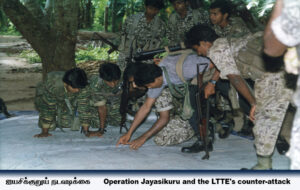 At the end of the fight, 6 fighters became maveerar on the side of the LTTE. The loss on the enemy’s side was 60. More than 200 soldiers were injured. As the west end of Mangulam is alert and strong, the army predicted that its east end would be vulnerable to attack. On the 24th February, in a space of ten days, the troops of Karipattamurippu attacked on the east of Olumadu. The LTTE retaliated aggressively. They killed more than 50 soldiers. The LTTE captured 20 of the body os the soldiers and handed them over to the Red Cross. 6 LTTE fighters were killed. As west and east are strong, the soldiers were defeated by the central part.
At the end of the fight, 6 fighters became maveerar on the side of the LTTE. The loss on the enemy’s side was 60. More than 200 soldiers were injured. As the west end of Mangulam is alert and strong, the army predicted that its east end would be vulnerable to attack. On the 24th February, in a space of ten days, the troops of Karipattamurippu attacked on the east of Olumadu. The LTTE retaliated aggressively. They killed more than 50 soldiers. The LTTE captured 20 of the body os the soldiers and handed them over to the Red Cross. 6 LTTE fighters were killed. As west and east are strong, the soldiers were defeated by the central part.
They examined it on 14th March. A fight broke out on the Mankulam main road side. The LTTE´s Four–One (4:1) Brigade guarded the centre. Capitalizing on the experience, Four-One allowed the Sinhalese to approach and then attacked. The enemy who came into the test of Four-One was caught in the tactical net. It was attacked well. The Sinhalese army fled, leaving behind the bodies and weapons of their comrades. Four-One Brigade captured 15 guns and five bodies of the enemy. Around 30 soldiers were killed in the fight. More than a hundred of the soldiers were injured – the LTTE’s central defenses stood untouched. At the same time, the command post in 55th Division, which was leading the attacks on the Mankulam LTTE base, was disturbed by the LTTE shelling on the same day. Shells fired by the LTTE artillery hit the enemy’s command post and injured the first command, Brigadier Sarath Fonseka and the second command, Brigadier Vorun, who must left the field.
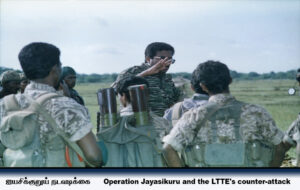 It is noteworthy that in this projectile attack, the artillery commander of the Sinhalese forces, an officer of the rank of colonel, was also killed. The determination of the Mankulam base withered the leadership of the soldiers. The Sinhalese commanders gathered and discussed what to do next. They planned to do something – somehow – to break the front of Mangulam. How to defend yourself against direct fire and indirect fire from the LTTE´s artillery! How to attack and win the guardians of the LTTE who stand firm! The Sinhalese commanders thought with the map spread out. They drew up a plan with the long space in front of the LTTE’s Olumadu ramparts and their armored forces inthe thougths. For the first time in Sinhalese military history, it prepared for a massive tank offensive. The elegance of the attack plan excited the commanders.
It is noteworthy that in this projectile attack, the artillery commander of the Sinhalese forces, an officer of the rank of colonel, was also killed. The determination of the Mankulam base withered the leadership of the soldiers. The Sinhalese commanders gathered and discussed what to do next. They planned to do something – somehow – to break the front of Mangulam. How to defend yourself against direct fire and indirect fire from the LTTE´s artillery! How to attack and win the guardians of the LTTE who stand firm! The Sinhalese commanders thought with the map spread out. They drew up a plan with the long space in front of the LTTE’s Olumadu ramparts and their armored forces inthe thougths. For the first time in Sinhalese military history, it prepared for a massive tank offensive. The elegance of the attack plan excited the commanders.
It was confident that the attack would succeed. The Sinhalese planned to take immediate advantage of the victory and make a swift advance to Mankulam junction. They planned the attack formally drawn up for this. One front is reserved for diversionary attacks. The plan was to attack Olumadu by the tank battalion – another strong force would move across the Kanagarayankulam and capture the Kanakarayan bridge on the Mankulam-Olumadu road – and from there move towards the Mankulam junction. It also planned to launch a diversionary attack Moonrumurippu front to add strength to this plan. By the time Jayasikkuru completes a year, the army chief hoped that this attack would bring about a decisive victory. On the morning of April 20th, the front was opened by the enemy’s artillery. The tanks of the enemy were drawn up on the outside in front of the Olumadu base.
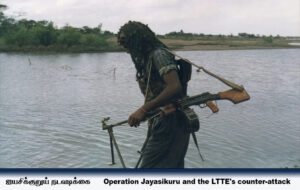 Around 20 armored vehicles were part of the armored team. It had Ri 55 assault rifles and gunners. The plan was to bombard the LTTE’s front line with bombs and then drop troops into the crumbling LTTE ramparts and take them down. A trooper can carry 10 soldiers in a barricade. A small number of special forces disembarking in troops hold the ruined ramparts for a few minutes while the infantry standing ready on the enemy base rushes in and seizes the Olumadu base. The offensive tactic of the tank battalion was to advance a certain distance in the clearing position and then line up the tanks and attack the front line. Then advance a further distance and come back to position and line up and attack the front line. The LTTE also started attacking the enemy’s armored team from a distance.
Around 20 armored vehicles were part of the armored team. It had Ri 55 assault rifles and gunners. The plan was to bombard the LTTE’s front line with bombs and then drop troops into the crumbling LTTE ramparts and take them down. A trooper can carry 10 soldiers in a barricade. A small number of special forces disembarking in troops hold the ruined ramparts for a few minutes while the infantry standing ready on the enemy base rushes in and seizes the Olumadu base. The offensive tactic of the tank battalion was to advance a certain distance in the clearing position and then line up the tanks and attack the front line. Then advance a further distance and come back to position and line up and attack the front line. The LTTE also started attacking the enemy’s armored team from a distance.
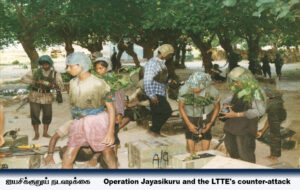 The battle now came within gunshot of the advance guard as the tanks advanced to meet the attack. Sothiya Brigade, Charles Antony Brigade and the Siruthay Brigade were on guard of the front line. Along with these, Colonel Kiddu’s Artillery Brigade and the Victor Anti-Armor Brigade launched a counter-attack. The front was dusty with shelling – shelling, gunshot and airstrikes. The dust shower engulfed the field to the extent that the eyes could not see the distance. Taking advantage of the dust, the army made a tank move towards the ramparts. Some ranks have touched the front line. The ramparts were destroyed in the tank attacks. The trees became dizzy. However, the LTTE fighters inside the ramparts did not leave their positions. They attacked the enemy without wavering. The LTTE destroyed a trooper and a tank at the front line Another Ri 55 tank was destroyed a short distance away. And some armor was damaged by shelling. The soldiers were unable to continue the effort. The attacks were repulsed and the tank went back to the point of departure. The tank strategic attack, the first in the history of the Sinhalese Army, ended in failure. At the same time, Jayanthan Brigade attacked the soldiers who wanted to move along the Kanagarayan rive and take the bridge – to reach the east gate of Mankulam. The enemy’s movement was stopped and turned back before reaching the ancient British bridge.
The battle now came within gunshot of the advance guard as the tanks advanced to meet the attack. Sothiya Brigade, Charles Antony Brigade and the Siruthay Brigade were on guard of the front line. Along with these, Colonel Kiddu’s Artillery Brigade and the Victor Anti-Armor Brigade launched a counter-attack. The front was dusty with shelling – shelling, gunshot and airstrikes. The dust shower engulfed the field to the extent that the eyes could not see the distance. Taking advantage of the dust, the army made a tank move towards the ramparts. Some ranks have touched the front line. The ramparts were destroyed in the tank attacks. The trees became dizzy. However, the LTTE fighters inside the ramparts did not leave their positions. They attacked the enemy without wavering. The LTTE destroyed a trooper and a tank at the front line Another Ri 55 tank was destroyed a short distance away. And some armor was damaged by shelling. The soldiers were unable to continue the effort. The attacks were repulsed and the tank went back to the point of departure. The tank strategic attack, the first in the history of the Sinhalese Army, ended in failure. At the same time, Jayanthan Brigade attacked the soldiers who wanted to move along the Kanagarayan rive and take the bridge – to reach the east gate of Mankulam. The enemy’s movement was stopped and turned back before reaching the ancient British bridge.
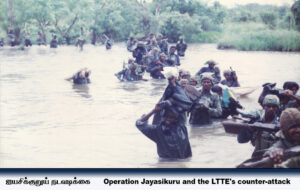 Both attacks, aimed at capturing the Olumadu Kanagarayan river bridge, failed. The diversionary attack on the Moonrumurippu was easily countered and repulsed by the Anbarasi Brigade. Jayasikkuru completed one year with these four fights for Mangulam. On the one year anniversary of May 13th 1998, Jayasikkurui base was quiet but the people of Vanni gathered on the streets to celebrate the successful one-year war. Jayasikkuru has entered its second year. A letter from the master of this land to the soldiers of Jayasikkuru……. No one doubts that Vanni has made you well aware by now that it is not so easy to get what you have in your mind. 30,000 soldiers, aircraft, artillery, armor, heavy artillery.. However, Jayasikkuru, which was accelerated by saying that it would be completed in three months, remains paralyzed even after 365 days. But what is quickly rising is the list of your dead, injured and missing soldires. Your military political leadership has never cared about you being killed, injured or missing. Not going to worry anymore. All they need are medals and titles.
Both attacks, aimed at capturing the Olumadu Kanagarayan river bridge, failed. The diversionary attack on the Moonrumurippu was easily countered and repulsed by the Anbarasi Brigade. Jayasikkuru completed one year with these four fights for Mangulam. On the one year anniversary of May 13th 1998, Jayasikkurui base was quiet but the people of Vanni gathered on the streets to celebrate the successful one-year war. Jayasikkuru has entered its second year. A letter from the master of this land to the soldiers of Jayasikkuru……. No one doubts that Vanni has made you well aware by now that it is not so easy to get what you have in your mind. 30,000 soldiers, aircraft, artillery, armor, heavy artillery.. However, Jayasikkuru, which was accelerated by saying that it would be completed in three months, remains paralyzed even after 365 days. But what is quickly rising is the list of your dead, injured and missing soldires. Your military political leadership has never cared about you being killed, injured or missing. Not going to worry anymore. All they need are medals and titles.
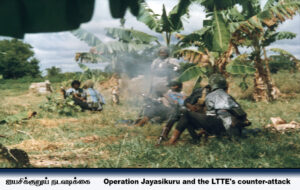 Rathwatha says the third month, then vesak, then changes it to new year and finally says that now it is not enough. How many comrades who stood next to you on vesak last new year are not alive today. Will you be there for next vesak? You know you wouldn’t be there if you continued here. Are any of the children of the politicians who are sitting on the luxury chairs in the Sri Lankan Parliament standing in the base? Not even one. They will be educated in overseas countries. Consider your position here. You stand without proper food, without water, shot in the head, mutilated by projectiles, and legless. The names of your officers, who command from air-conditioned vehicles far away without the sound of gunfire being ,recommended for promotion and medals, and you are listed on the missing persons list. How many times have you changed your military commanders and tactics? Yet your deaths are cheap.
Rathwatha says the third month, then vesak, then changes it to new year and finally says that now it is not enough. How many comrades who stood next to you on vesak last new year are not alive today. Will you be there for next vesak? You know you wouldn’t be there if you continued here. Are any of the children of the politicians who are sitting on the luxury chairs in the Sri Lankan Parliament standing in the base? Not even one. They will be educated in overseas countries. Consider your position here. You stand without proper food, without water, shot in the head, mutilated by projectiles, and legless. The names of your officers, who command from air-conditioned vehicles far away without the sound of gunfire being ,recommended for promotion and medals, and you are listed on the missing persons list. How many times have you changed your military commanders and tactics? Yet your deaths are cheap.
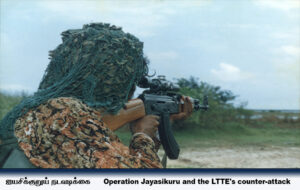 Ashoka Jayawardana came in full force. They said the army is dying. He was sent. Sirilal Weerasuriya came. They said he was the best commander. It was your special forces in Mannakulam that were destroyed. Think about why you joined the forces. To save your poor families, to save your sick mother, to marry off your sisters, but what is happening here? Your bodies are melting away in a corner somewhere while your loved ones are suffering here. Your soldiers become less by the loss of dead, wounded, and non-returned troops, while our legions become stronger by the addition of new recruits. With captured and destroyed, your weaponry is in question. Our weaponry is moving towards a great state as captured weapons dropped in the battlefields. The arms of friendship that extend to us across the seas and above all the incomparable generosity of our people infuses us with a new energy. When Thandikulam was blown up, when Karappukkuththy-Vinjanakulam was destroyed, when you were crushed to dust in Mannakulam, when you were chased away in Olumadu, and finally when your tanks were crushed, neither the air planes nor the artillery heard your cry. Aniruth and Thaluvath didn’t rush to help you.
Ashoka Jayawardana came in full force. They said the army is dying. He was sent. Sirilal Weerasuriya came. They said he was the best commander. It was your special forces in Mannakulam that were destroyed. Think about why you joined the forces. To save your poor families, to save your sick mother, to marry off your sisters, but what is happening here? Your bodies are melting away in a corner somewhere while your loved ones are suffering here. Your soldiers become less by the loss of dead, wounded, and non-returned troops, while our legions become stronger by the addition of new recruits. With captured and destroyed, your weaponry is in question. Our weaponry is moving towards a great state as captured weapons dropped in the battlefields. The arms of friendship that extend to us across the seas and above all the incomparable generosity of our people infuses us with a new energy. When Thandikulam was blown up, when Karappukkuththy-Vinjanakulam was destroyed, when you were crushed to dust in Mannakulam, when you were chased away in Olumadu, and finally when your tanks were crushed, neither the air planes nor the artillery heard your cry. Aniruth and Thaluvath didn’t rush to help you.
What else do you believe in?:
Who are you fighting for?
For your parents?
For your children?
For your wife?
They will love you more than the few thousand rupees you send them. Rather than being an unjust victim in an unjust war, decide to live happily with your sweet relationships. We are not fighting for your backyard in Galle or Matara or Gurunagal. We are fighting against the racist occupation of our ancestral land.
This land is our own land. The land where our parents and their parents were born, crawled, grew and lived and Finally, we want to tell you something. It is a fight for our lives. This is our historical duty, the death we meet here is a history.
This land has become one with our consciousness and life. We will fight fiercely for every inch of this land. We will not allow any aggressor to remain in our land. We will kill everyone.
‘Success is sure not for you but for us’
where we and our children will live today.
![]()
Operation Jayasikurui Nadavadikkaiyim PUlikalin
Viduthalaipulikal Papper – Kural 83
